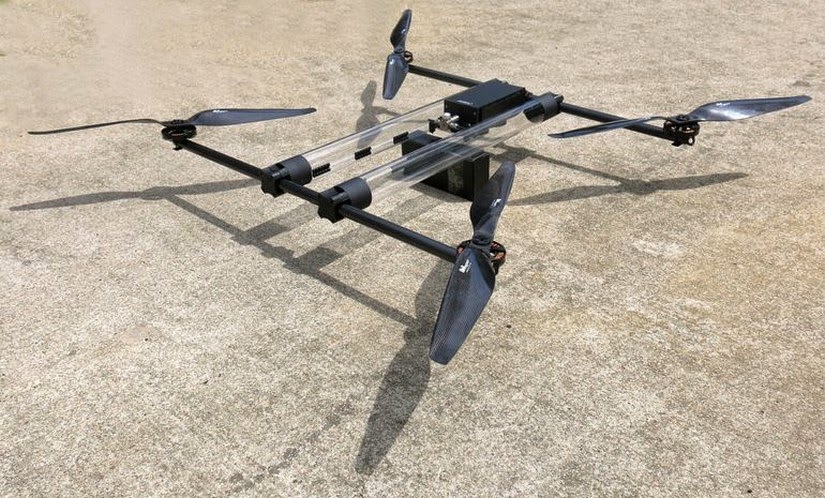How embarrassing would it appear if you, a consumer drone owner (stay with me), are showing off your zippy new drone to the neighbors when suddenly, after about 10 minutes of soaring above rooftops and scaring birds off telephone wires, your drone loses all power and drops like a wingless fly into the yard, scattering your admirers.
Oops. Someone forgot to recharge the drone’s batteries. And, now, the neighbors will talk.
The limit in the power and durability of lithium ion and polymer battery technology (what powers your now-crumpled drone) is nearing. Not only that, while you’ve certainly enjoyed your toy, perhaps you feel uneasy about the environmental issues associated with disposal of its batteries. When disposed of in an unlined landfill, some types of batteries can leach its toxic constituents and contaminate groundwater, resulting in possible exposure to humans.
Anyway, we may have an answer to your portable power issues (and commendable environmental concerns). Well, not we specifically, but an energy technology company.
Earlier this month at CES (the mega-event of all things technology), a hydrogen fuel cell-powered range extender for drones debuted. The product offers longer flight time and fast refuel capabilities, addressing two of the biggest challenges for manufacturers of battery-powered drones,
according to Intelligent Energy. The U.K.-based company
specializes in the development of Proton Exchange Membrane (PEM) fuel cells for the global automotive, consumer electronics, distributed power and generation markets
.
WHAT IS PEMFC TECHNOLOGY?
Like batteries, fuel cells produce electric power. The fundamental elements of a proton exchange membrane fuel cell (PEMFC) include the anode, the cathode, the membrane and the catalyst,
explains BCC Research analyst Donald Saxman.
A PEMFC generates electricity directly from a fuel source, such as hydrogen, and an oxidant, such as oxygen from the air.
“Hydrogen is considered an ideal energy source; at least from a thermodynamics standpoint,” Saxman says. “Hydrogen feed fuel cells are based on the electrochemical reaction between hydrogen and oxygen. This electrochemical process doesn’t pollute the environment with hydrocarbons, particulates or any sulfur or nitrogen oxides.”
Since the process does not burn the fuel to produce heat, the thermodynamic limits on efficiency are higher than normal power generation processes. The fuel cell consists of two catalytic electrodes separated by an ion-conducting membrane that serves as the electrolyte. The hydrogen is ionized on one electrode, and the hydrogen ions diffuse across the membrane to recombine with the oxygen ions on the surface of the other electrode.
“PEMFCs can be compact in design, offer a long operating life and quick startup, operate at low temperature and can demonstrate high energy density,” Saxman says of the qualities that make PEMFCs attractive for powering fuel cell powered vehicles.
Intelligent Energy’s range extender offers up to several hours of drone flight time rather than the typical 20 minutes’ maximum flight times. In addition, fuel cells can significantly reduce the downtime currently required for recharging between flights–from one to two hours to an average of two minutes.
According to Saxman, fuel cell vehicles are currently in an early commercial phase of production. The PEM fuel cells market is not only hindered by the short range and long recharging times associated with batteries, but also by the cost to commercialize fuels cells.
“For PEMs or any of the other fuel cell technologies to be commercially viable, fuel cells must meet durability and performance requirements in comparison to incumbent technologies such as advanced batteries and improved internal combustion engines,” says Saxman. The cost of building fuel cells must be reduced so that fuel cells are priced competitively with established technologies. The few fuel cell vehicles available are hand-made in relatively low volume.
There needs to be volume production, system simplification and standardization combined with the use of lower cost components to produce a vehicle that is affordable and is profitable for the manufacturer, he adds.
Perhaps for now, owning your drone isn’t financially feasible. That’s likely a good thing. Because when you can afford one, by then maybe the drone’s current power limitations will be a thing of the past. All that hang time will definitely impress your neighbors.
The global market for proton exchange membrane fuel cell (PEMFC) membrane electrode assemblies (MEA) reached $340 million and $460 million in 2010 and 2014, respectively. This market is expected to reach $534 million by 2015 and $1.9 billion by 2020, registering a compound annual growth rate (CAGR) of 29.4% from 2015 to 2020.




